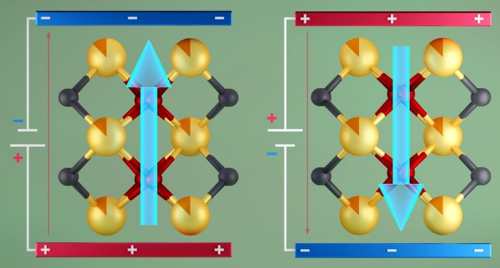Innovative Ferroelectric Material Could Enable Next-Gen Memory Devices
Hafnia-based ferroelectric materials may help to miniaturize non-volatile memory devices, but researchers have not developed bulk form of material.
This is a Press Release edited by StorageNewsletter.com on June 28, 2022 at 2:04 pmFrom Office of Scientific and Technical Information, U.S. Department of Energy, USA
Ferroelectric materials are substances with spontaneous electrical polarization. Polarization refers to the separation of the negative and positive charges within a material.
Structure of yttrium (partially shaded orange) doped hafnia dioxide crystals exhibits ferroelectric polarization (blue arrows) that changes direction as external electric field is reversed.
(Source: Oak Ridge National Laboratory)

For ferroelectric materials, this means the ‘memory’ of the material’s prior state (referred to as hysteresis) can store information in a way similar to magnetic storage devices such as hard disks. Ferroelectric materials based on the element hafnium show promise because they are more compatible with today’s silicon computer circuits than other potential materials. In the past, researchers achieved ferroelectricity on ultrathin films. These films can be delicate and hard to use. Scientists have now reported the first experimental evidence of room-temperature ferroelectricity in crystals made of a hafnium-based compound, bulk yttrium doped hafnium dioxide.
Impact
Hafnia-based ferroelectric materials have many benefits for computer memory. They offer high speed, durability, lower operating power, and the ability to retain data when power is turned off. However, researchers do not fully understand these materials. This research developed an innovative bulk hafnia-based ferroelectric material. The results provide insights into how these materials behave and how to control them. The results also remove the materials’ upper size limit, making such materials easier to use in real-world applications. The large sample size will aid further experiments to better understand the material’s ferroelectric properties. This in turn will help researchers create next-gen non-volatile memory devices.
Summary
Gordon Moore, co-founder, Intel Corp., postulated in 1965 that the number of transistors on a computer chip would double every 2 years, a prediction known as the Moore’s Law. Chip manufacturers since have been able to maintain this rate of miniaturization but face increasing challenges due to the laws of physics. Hafnia-based ferroelectric materials may help to further miniaturize non-volatile memory devices, but researchers have not developed a bulk form of the material. The new bulk ferroelectric yttrium doped hafnium dioxide developed in this research could enable such development, leading to more use of hafnia on computer chips and extending Moore’s Law.
A team of researchers led by Rutgers University performed neutron powder diffraction measurements on yttrium doped hafnium dioxide using the POWGEN, a general-purpose powder diffractometer instrument at the Spallation Neutron Source, a Department of Energy (DOE) user facility at Oak Ridge National Laboratory (ORNL). POWGEN is a high-resolution neutron powder diffractometer that enables characterizing the crystal, magnetic, and local structures of novel polycrystalline materials. The team synthesized single crystals of yttrium doped hafnium dioxide at various yttrium doping levels and ground them into powder for characterization. POWGEN data showed that at certain doping levels, the bulk phases were stable and the oxygen atoms shifted to enable reversible polarization, thus confirming the hafnia’s ferroelectricity at room temperatures. Other measurements, including polarization-electric field hysteresis loop and computational simulations, supported the structural analyses, representing an important step forward towards future hafnia-based technologies.
Funding
The research was supported by the Centre for Quantum Materials Synthesis funded by the Gordon and Betty Moore Foundation’s EPiQS initiative, Rutgers University, the Office of Naval Research, and the Department of Defense. The neutron characterization was performed with the Spallation Neutron Source, a DOE Office of Science user facility at ORNL.
Article: Kinetically stabilized ferroelectricity in bulk single-crystalline HfO2:Y
Nature Materials has published an article written by Xianghan Xu, Fei-Ting Huang, Rutgers Center for Emergent Materials, Rutgers University, Piscataway, NJ, USA, and Department of Physics & Astronomy, Rutgers University, Piscataway, NJ, USA, Yubo Qi, Sobhit Singh, Karin M. Rabe, Department of Physics & Astronomy, Rutgers University, Piscataway, NJ, USA, Dimuthu Obeysekera, Department of Physics, New Jersey Institute of Technology, Newark, NJ, USA, Junjie Yang, Department of Physics, New Jersey Institute of Technology, Newark, NJ, USA, Ming-Wen Chu, Center for Condensed Matter Sciences, National Taiwan University, Taipei, Taiwan, and Center of Atomic Initiative for New Materials, National Taiwan University, Taipei, Taiwan, Sang-Wook Cheong, Rutgers Center for Emergent Materials, Rutgers University, Piscataway, NJ, USA, and Department of Physics & Astronomy, Rutgers University, Piscataway, NJ, USA .
Abstract: “HfO2, a simple binary oxide, exhibits ultra-scalable ferroelectricity integrable into silicon technology. This material has a polymorphic nature, with the polar orthorhombic (Pbc21) form in ultrathin films regarded as the plausible cause of ferroelectricity but thought not to be attainable in bulk crystals. In this work, using a state-of-the-art laser-diode-heated floating zone technique, we report the Pbc21 phase and ferroelectricity in bulk single-crystalline HfO2:Y as well as the presence of the antipolar Pbca phase at different Y concentrations. Neutron diffraction and atomic imaging demonstrate (anti)polar crystallographic signatures and abundant 90°/180° ferroelectric domains in addition to switchable polarization with negligible wake-up effects. Density-functional-theory calculations indicate that the yttrium doping and rapid cooling are the key factors for stabilization of the desired phase in bulk. Our observations provide insights into the polymorphic nature and phase control of HfO2, remove the upper size limit for ferroelectricity and suggest directions towards next-generation ferroelectric devices.“














 Subscribe to our free daily newsletter
Subscribe to our free daily newsletter

